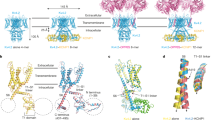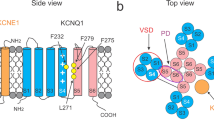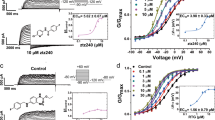Abstract
KChIPs coassemble with pore-forming Kv4 α subunits to form a native complex in the brain and heart and regulate the expression and gating properties of Kv4 K+ channels, but the mechanisms underlying these processes are unknown. Here we report a co-crystal structure of the complex of human Kv4.3 N-terminus and KChIP1 at a 3.2-Å resolution. The structure reveals a unique clamping action of the complex, in which a single KChIP1 molecule, as a monomer, laterally clamps two neighboring Kv4.3 N-termini in a 4:4 manner, forming an octamer. The proximal N-terminal peptide of Kv4.3 is sequestered by its binding to an elongated groove on the surface of KChIP1, which is indispensable for the modulation of Kv4.3 by KChIP1, and the same KChIP1 molecule binds to an adjacent T1 domain to stabilize the tetrameric Kv4.3 channels. Taken together with biochemical and functional data, our findings provide a structural basis for the modulation of Kv4 by KChIPs.
This is a preview of subscription content, access via your institution
Access options
Subscribe to this journal
Receive 12 print issues and online access
$209.00 per year
only $17.42 per issue
Buy this article
- Purchase on Springer Link
- Instant access to full article PDF
Prices may be subject to local taxes which are calculated during checkout






Similar content being viewed by others
Accession codes
References
Abbott, G.W. & Goldstein, S.A. A superfamily of small potassium channel subunits: form and function of the MinK-related peptides (MiRPs). Q. Rev. Biophys. 31, 357–398 (1998).
Trimmer, J.S. Regulation of ion channel expression by cytoplasmic subunits. Curr. Opin. Neurobiol. 8, 370–374 (1998).
Shibata, R. et al. A fundamental role for KChIPs in determining the molecular properties and trafficking of Kv4.2 potassium channels. J. Biol. Chem. 278, 36445–36454 (2003).
Birnbaum, S.G. et al. Structure and function of Kv4-family transient potassium channels. Physiol. Rev. 84, 803–833 (2004).
Rhodes, K.J. et al. KChIPs and Kv4 alpha subunits as integral components of A-type potassium channels in mammalian brain. J. Neurosci. 24, 7903–7915 (2004).
An, W.F. et al. Modulation of A-type potassium channels by a family of calcium sensors. Nature 403, 553–556 (2000).
Kuo, H.C. et al. A defect in the Kv channel-interacting protein 2 (KChIP2) gene leads to a complete loss of I(to) and confers susceptibility to ventricular tachycardia. Cell 107, 801–813 (2001).
Holmqvist, M.H. et al. Elimination of fast inactivation in Kv4 A-type potassium channels by an auxiliary subunit domain. Proc. Natl. Acad. Sci. USA 99, 1035–1040 (2002).
Nadal, M.S. et al. The CD26-related dipeptidyl aminopeptidase-like protein DPPX is a critical component of neuronal A-type K+ channels. Neuron 37, 449–461 (2003).
Connor, J.A. & Stevens, C.F. Voltage clamp studies of a transient outward membrane current in gastropod neural somata. J. Physiol. (Lond.) 213, 21–30 (1971).
Sheng, M., Tsaur, M.L., Jan, Y.N. & Jan, L.Y. Subcellular segregation of two A-type K+ channel proteins in rat central neurons. Neuron 9, 271–284 (1992).
Serodio, P., Vega-Saenz de Miera, E. & Rudy, B. Cloning of a novel component of A-type K+ channels operating at subthreshold potentials with unique expression in heart and brain. J. Neurophysiol. 75, 2174–2179 (1996).
Johnston, D. et al. Dendritic potassium channels in hippocampal pyramidal neurons. J. Physiol. (Lond.) 525, 75–81 (2000).
Malin, S.A. & Nerbonne, J.M. Elimination of the fast transient in superior cervical ganglion neurons with expression of KV4.2W362F: molecular dissection of IA. J. Neurosci. 20, 5191–5199 (2000).
Shibata, R. et al. A-type K+ current mediated by the Kv4 channel regulates the generation of action potential in developing cerebellar granule cells. J. Neurosci. 20, 4145–4155 (2000).
Schoppa, N.E. & Westbrook, G.L. Regulation of synaptic timing in the olfactory bulb by an A-type potassium current. Nat. Neurosci. 2, 1106–1113 (1999).
Kunjilwar, K., Strang, C., DeRubeis, D. & Pfaffinger, P.J. KChIP3 rescues the functional expression of Shal channel tetramerization mutants. J. Biol. Chem. 279, 54542–54551 (2004).
Jahng, A.W. et al. Zinc mediates assembly of the T1 domain of the voltage-gated K channel 4.2. J. Biol. Chem. 277, 47885–47890 (2002).
Scannevin, R.H. et al. Two N-terminal domains of Kv4 K+ channels regulate binding to and modulation by KChIP1. Neuron 41, 587–598 (2004).
Li, M., Jan, Y.N. & Jan, L.Y. Specification of subunit assembly by the hydrophilic amino-terminal domain of the Shaker potassium channel. Science 257, 1225–1230 (1992).
Zhou, W., Qian, Y., Kunjilwar, K., Pfaffinger, P.J. & Choe, S. Structural insights into the functional interaction of KChIP1 with Shal-type K+ channels. Neuron 41, 573–586 (2004).
Kim, L.A. et al. Three-dimensional structure of I(to); Kv4.2-KChIP2 ion channels by electron microscopy at 21 Angstrom resolution. Neuron 41, 513–519 (2004).
Gulbis, J.M., Zhou, M., Mann, S. & MacKinnon, R. Structure of the cytoplasmic beta subunit-T1 assembly of voltage-dependent K+ channels. Science 289, 123–127 (2000).
Orlova, E.V., Papakosta, M., Booy, F.P., van Heel, M. & Dolly, J.O. Voltage-gated K+ channel from mammalian brain: 3D structure at 18A of the complete (alpha)4(beta)4 complex. J. Mol. Biol. 326, 1005–1012 (2003).
Jerng, H.H. & Covarrubias, M.K. K+ channel inactivation mediated by the concerted action of the cytoplasmic N- and C-terminal domains. Biophys. J. 72, 163–174 (1997).
Jerng, H.H., Shahidullah, M. & Covarrubias, M. Inactivation gating of Kv4 potassium channels: molecular interactions involving the inner vestibule of the pore. J. Gen. Physiol. 113, 641–660 (1999).
Gebauer, M. et al. N-type inactivation features of Kv4.2 channel gating. Biophys. J. 86, 210–223 (2004).
Lewit-Bentley, A. & Rety, S. EF-hand calcium-binding proteins. Curr. Opin. Struct. Biol. 10, 637–643 (2000).
Baldwin, T.J., Tsaur, M.L., Lopez, G.A., Jan, Y.N. & Jan, L.Y. Characterization of a mammalian cDNA for an inactivating voltage-sensitive K+ channel. Neuron 7, 471–483 (1991).
Beck, E.J., Bowlby, M., An, W.F., Rhodes, K.J. & Covarrubias, M. Remodelling inactivation gating of Kv4 channels by KChIP1, a small-molecular-weight calcium-binding protein. J. Physiol. (Lond.) 538, 691–706 (2002).
Shi, G. et al. Beta subunits promote K+ channel surface expression through effects early in biosynthesis. Neuron 16, 843–852 (1996).
Gulbis, J.M., Mann, S. & MacKinnon, R. Structure of a voltage-dependent K+ channel beta subunit. Cell 97, 943–952 (1999).
Long, S.B., Campbell, E.B. & Mackinnon, R. Crystal structure of a mammalian voltage-dependent Shaker family K+ channel. Science 309, 897–903 (2005).
Otwinowski, Z. & Minor, W. Processing of X-ray diffraction data collected in oscillation mode. in Methods in Enzymology, 307–326 (eds. Carter Jr., C.W. & Sweet, R.M.) (Academic Press, New York, 1997).
CCP4 (Collaborative Computational Project 4). The CCP4 suite programs for protein crystallography. Acta Crystallogr. D 50, 760–763 (1994).
Brunger, A.T. et al. Crystallography & NMR system: a new software suite for macromolecular structure determination. Acta Crystallogr. D Biol. Crystallogr. 54, 905–921 (1998).
Acknowledgements
We thank V.J. Karplus for helpful comments on this manuscript and P. Liang for technical support. K.W.W. thanks J. S. Han, Y. Wan and C. Zhou for their support, and specially thanks J. M. Wang for her consistent support and understanding. This work was supported by the '985' grant from the Chinese Ministry of Education and the grant for Project 30630017 by the National Science Foundation of China to K.W.W. and the '863' grant (2003-AA210090) from the Chinese Ministry of Science and Technology to J.J.C. The crystallographic data were collected at the Cornell High Energy Synchrotron Source, which is supported by the National Science Foundation and the National Institute of Health under awards DMR-0225180 and RR01646.
Author information
Authors and Affiliations
Contributions
H.W. performed the structural biochemistry experiments and Y.Y. conducted the electrophysiology and part of the molecular biology experiments. Q.L., Q.Y. and Q.H. collected the structural data. Y.H, Y.C. and L.C. provided support in for the molecular biology experiments. Y.C. provided electrophysiology support. K.W.W. and J.C. designed and supervised the experiments and wrote the manuscript.
Corresponding authors
Ethics declarations
Competing interests
The authors declare no competing financial interests.
Rights and permissions
About this article
Cite this article
Wang, H., Yan, Y., Liu, Q. et al. Structural basis for modulation of Kv4 K+ channels by auxiliary KChIP subunits. Nat Neurosci 10, 32–39 (2007). https://doi.org/10.1038/nn1822
Received:
Accepted:
Published:
Issue Date:
DOI: https://doi.org/10.1038/nn1822
This article is cited by
-
Structural basis of gating modulation of Kv4 channel complexes
Nature (2021)
-
Modulation of human Kv4.3/KChIP2 channel inactivation kinetics by cytoplasmic Ca2+
Pflügers Archiv - European Journal of Physiology (2017)
-
First de novo KCND3 mutation causes severe Kv4.3 channel dysfunction leading to early onset cerebellar ataxia, intellectual disability, oral apraxia and epilepsy
BMC Medical Genetics (2015)
-
T-type channels buddy up
Pflügers Archiv - European Journal of Physiology (2014)
-
Identification of key structural elements for neuronal calcium sensor-1 function in the regulation of the temperature-dependency of locomotion in C. elegans
Molecular Brain (2013)



